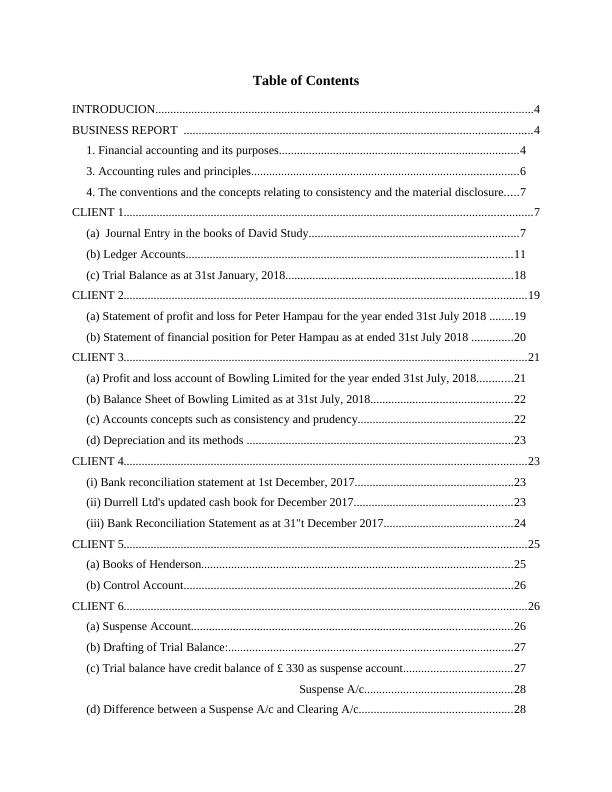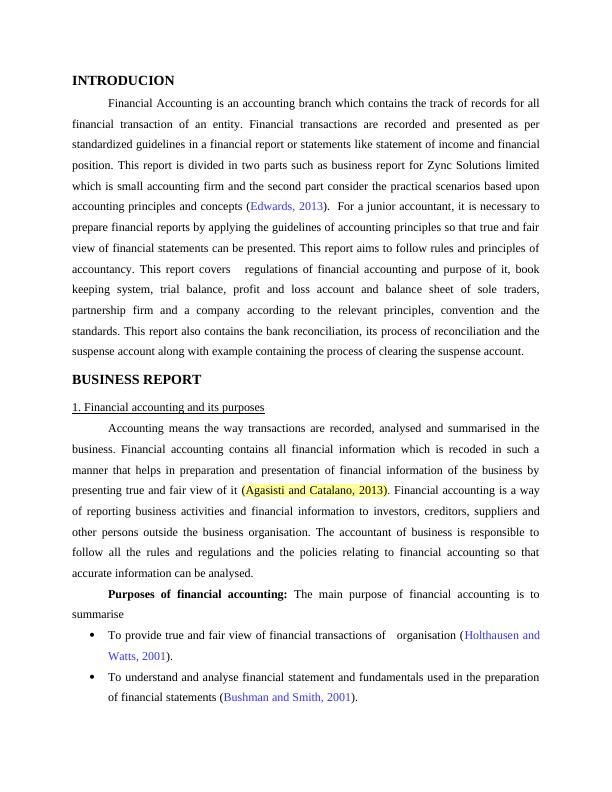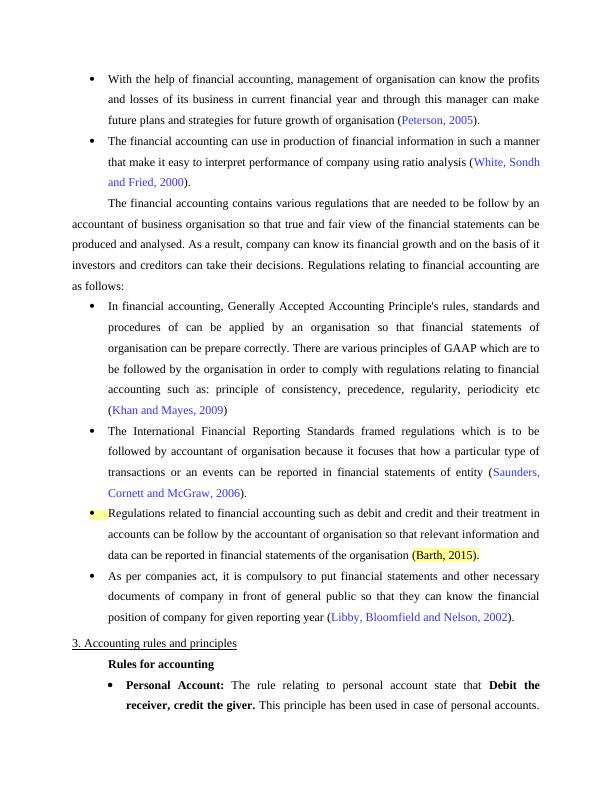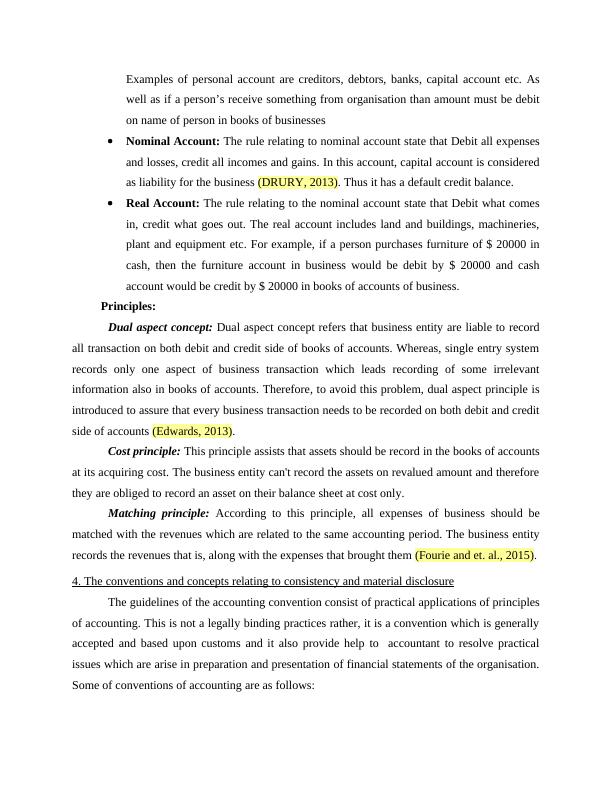Financial Accounting Assignment - Zync Solutions
29 Pages5360 Words97 Views
Added on 2020-12-10
Financial Accounting Assignment - Zync Solutions
Added on 2020-12-10
ShareRelated Documents
Financial Accounting

Table of ContentsINTRODUCION..............................................................................................................................4BUSINESS REPORT ....................................................................................................................41. Financial accounting and its purposes................................................................................43. Accounting rules and principles.........................................................................................64. The conventions and the concepts relating to consistency and the material disclosure.....7CLIENT 1........................................................................................................................................7(a) Journal Entry in the books of David Study......................................................................7(b) Ledger Accounts.............................................................................................................11(c) Trial Balance as at 31st January, 2018............................................................................18CLIENT 2......................................................................................................................................19(a) Statement of profit and loss for Peter Hampau for the year ended 31st July 2018 ........19(b) Statement of financial position for Peter Hampau as at ended 31st July 2018 ..............20CLIENT 3......................................................................................................................................21(a) Profit and loss account of Bowling Limited for the year ended 31st July, 2018............21(b) Balance Sheet of Bowling Limited as at 31st July, 2018...............................................22(c) Accounts concepts such as consistency and prudency....................................................22(d) Depreciation and its methods .........................................................................................23CLIENT 4......................................................................................................................................23(i) Bank reconciliation statement at 1st December, 2017.....................................................23(ii) Durrell Ltd's updated cash book for December 2017.....................................................23(iii) Bank Reconciliation Statement as at 31"t December 2017...........................................24CLIENT 5......................................................................................................................................25(a) Books of Henderson........................................................................................................25(b) Control Account..............................................................................................................26CLIENT 6......................................................................................................................................26(a) Suspense Account...........................................................................................................26(b) Drafting of Trial Balance:...............................................................................................27(c) Trial balance have credit balance of £ 330 as suspense account....................................27Suspense A/c.................................................28(d) Difference between a Suspense A/c and Clearing A/c...................................................28


INTRODUCIONFinancial Accounting is an accounting branch which contains the track of records for allfinancial transaction of an entity. Financial transactions are recorded and presented as perstandardized guidelines in a financial report or statements like statement of income and financialposition. This report is divided in two parts such as business report for Zync Solutions limitedwhich is small accounting firm and the second part consider the practical scenarios based uponaccounting principles and concepts (Edwards, 2013). For a junior accountant, it is necessary toprepare financial reports by applying the guidelines of accounting principles so that true and fairview of financial statements can be presented. This report aims to follow rules and principles ofaccountancy. This report covers regulations of financial accounting and purpose of it, bookkeeping system, trial balance, profit and loss account and balance sheet of sole traders,partnership firm and a company according to the relevant principles, convention and thestandards. This report also contains the bank reconciliation, its process of reconciliation and thesuspense account along with example containing the process of clearing the suspense account.BUSINESS REPORT 1. Financial accounting and its purposesAccounting means the way transactions are recorded, analysed and summarised in thebusiness. Financial accounting contains all financial information which is recoded in such amanner that helps in preparation and presentation of financial information of the business bypresenting true and fair view of it (Agasisti and Catalano, 2013). Financial accounting is a wayof reporting business activities and financial information to investors, creditors, suppliers andother persons outside the business organisation. The accountant of business is responsible tofollow all the rules and regulations and the policies relating to financial accounting so thataccurate information can be analysed.Purposes of financial accounting: The main purpose of financial accounting is tosummarise To provide true and fair view of financial transactions of organisation (Holthausen andWatts, 2001). To understand and analyse financial statement and fundamentals used in the preparationof financial statements (Bushman and Smith, 2001).

With the help of financial accounting, management of organisation can know the profitsand losses of its business in current financial year and through this manager can makefuture plans and strategies for future growth of organisation (Peterson, 2005). The financial accounting can use in production of financial information in such a mannerthat make it easy to interpret performance of company using ratio analysis (White, Sondhand Fried, 2000).The financial accounting contains various regulations that are needed to be follow by anaccountant of business organisation so that true and fair view of the financial statements can beproduced and analysed. As a result, company can know its financial growth and on the basis of itinvestors and creditors can take their decisions. Regulations relating to financial accounting areas follows: In financial accounting, Generally Accepted Accounting Principle's rules, standards andprocedures of can be applied by an organisation so that financial statements oforganisation can be prepare correctly. There are various principles of GAAP which are tobe followed by the organisation in order to comply with regulations relating to financialaccounting such as: principle of consistency, precedence, regularity, periodicity etc(Khan and Mayes, 2009)The International Financial Reporting Standards framed regulations which is to befollowed by accountant of organisation because it focuses that how a particular type oftransactions or an events can be reported in financial statements of entity (Saunders,Cornett and McGraw, 2006). Regulations related to financial accounting such as debit and credit and their treatment inaccounts can be follow by the accountant of organisation so that relevant information anddata can be reported in financial statements of the organisation (Barth, 2015).As per companies act, it is compulsory to put financial statements and other necessarydocuments of company in front of general public so that they can know the financialposition of company for given reporting year (Libby, Bloomfield and Nelson, 2002). 3. Accounting rules and principlesRules for accountingPersonal Account: The rule relating to personal account state that Debit thereceiver, credit the giver. This principle has been used in case of personal accounts.

Examples of personal account are creditors, debtors, banks, capital account etc. Aswell as if a person’s receive something from organisation than amount must be debiton name of person in books of businessesNominal Account: The rule relating to nominal account state that Debit all expensesand losses, credit all incomes and gains. In this account, capital account is consideredas liability for the business (DRURY, 2013). Thus it has a default credit balance.Real Account: The rule relating to the nominal account state that Debit what comesin, credit what goes out. The real account includes land and buildings, machineries,plant and equipment etc. For example, if a person purchases furniture of $ 20000 incash, then the furniture account in business would be debit by $ 20000 and cashaccount would be credit by $ 20000 in books of accounts of business. Principles:Dual aspect concept: Dual aspect concept refers that business entity are liable to recordall transaction on both debit and credit side of books of accounts. Whereas, single entry systemrecords only one aspect of business transaction which leads recording of some irrelevantinformation also in books of accounts. Therefore, to avoid this problem, dual aspect principle isintroduced to assure that every business transaction needs to be recorded on both debit and creditside of accounts (Edwards, 2013).Cost principle: This principle assists that assets should be record in the books of accountsat its acquiring cost. The business entity can't record the assets on revalued amount and thereforethey are obliged to record an asset on their balance sheet at cost only.Matching principle: According to this principle, all expenses of business should bematched with the revenues which are related to the same accounting period. The business entityrecords the revenues that is, along with the expenses that brought them (Fourie and et. al., 2015). 4. The conventions and concepts relating to consistency and material disclosureThe guidelines of the accounting convention consist of practical applications of principlesof accounting. This is not a legally binding practices rather, it is a convention which is generallyaccepted and based upon customs and it also provide help to accountant to resolve practicalissues which are arise in preparation and presentation of financial statements of the organisation.Some of conventions of accounting are as follows:

End of preview
Want to access all the pages? Upload your documents or become a member.
Related Documents
Financial Accounting Principles Assignment - Doclg...
|30
|7212
|286
Introduction to Financial Accountinglg...
|30
|5105
|401
Financial Accounting Principles Assignment - RBS Accountants Ltdlg...
|26
|7021
|485
Finance Accounting INTRODUCTION 4 BUSINESS RPORTlg...
|25
|7261
|384
1.Financial Accounting and its Purposeslg...
|27
|6999
|247
Financial Accounting Principles INTRODUCTIONlg...
|27
|6810
|416
